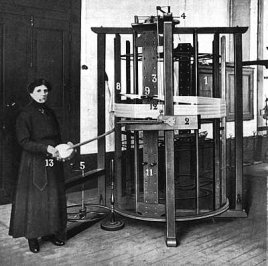- Home
- Resurrection ▾
-
Learn ▾
- Free library
- Glossary
- Documents
- Initiation
-
Shaped fabrics
- Introduction
- Popularization
- Definitions
- Le métier de façonné
- Principes du façonné
- Mécaniques de façonné
- Le jeu des crochets
- Les cartons
- Chaîne des cartons
- Mécanique 104 en détail
- Pour en finir
- Montage façonné
- Empoutage 1/3
- Empoutage 2/3
- Empoutage 3/3
- Punching, hanging and dip
- Autres façonnés
- Façonnés et Islam
-
Cours de tissage 1912
- Bâti d'un métier
- Le rouleau arrière
- Les bascules
- Formation du pas
- Position de organes
- Mécanique 104 Jacquard
- Fonctionnement 104
- Lisage des cartons
- Le battant du métier
- Le régulateur
- Réduction et régulateur
- Mise au métier d'une chaîne
- Mise en route du métier
- Navettes à soie
- Battage
- Ourdissage mécanique
- Préparation chaînes et trames
- Equipment ▾
- Chronicles ▾
- Fabrics ▾
- Techniques ▾
- Culture ▾
- Language ▾
Sectional view of a mechanical warping machine Diederichs
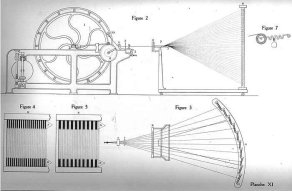
The winding on the warp beam is done directly from the back of the drum of the horizontal warping machine. The work is superior in quality and quantity.
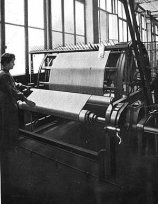
The warp is first wound on the drum from a creel with 400 or 800 silk wood spools against 40 in hand weaving...
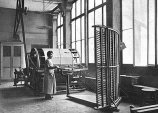
Arm-winding requires additional handling that does not require mechanical warping since the warp is wound on the beam directly from the drum of the horizontal warping machine ...
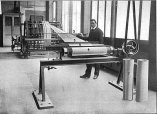
It must now be removed from the warping machine to be wound on the folding drum ...
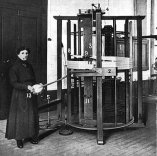
The warp is first woven on the drum ...
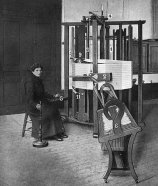
The mechanical warper is constituted by a horizontal drum capable of rotating about its axis and at the same time advancing in a direction parallel to this axis. The exact juxtaposition of each halfporter is ensured by the passage of the threads through the teeth of a reed which adjusts the winding width. The dimensions of the drum are such that the warp is distributed along an axis length equal to the width of the fabric for which it is intended.
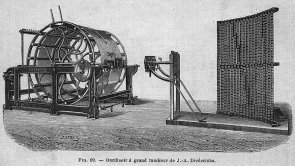
The warping machine is a large hollow, cylindrical drum, two meters high, the axis of which must be perfectly vertical. The worker gives the warping machine a rotating movement by means of a crank. She first winds the first halfporter (40 threads) from top to bottom on the drum, then juxtaposes a second halfporter up and down and continues until the desired number of halfporters or porters has been put on the warping machine. An apparatus called a heck box, movable along the vertical, serves as a guide to each halfporter and allows it to wind in a determined spiral. It is essential, in warping, to give each thread its determined rank ; the threads must be distinct enough so that the true place of the broken threads can be found. When the warping machine has received a sufficient number of halfporters, the worker raises the warp and wraps it around a peg in a very tight ball.
In larger workshops, a sophisticated apparatus was used, a mechanical warping machine providing more consistent results:
The purpose of warping is to prepare the fabric warp. The threads of the same length and number, which are to form the warp, must be juxtaposed in parallel with a uniform tension. Their respective places must also be preserved, otherwise the threads could become entangled and the weaving of the warp would become impossible. The warping machine which assembles the threads to form a warp receives the wood spools from the manufacturer with an indication of the number of threads to be joined. The 40-threaded assembly is called the halfporter, the 80-yard is called the porter. A warp of 100 meters composed of forty wood spools is therefore formed of 3200 threads of a length of 100 meters.
The apparatus used for warping consists of a horizontal or vertical frame bearing 40 wood spools, forming a halfporter, and the warping machine proper.
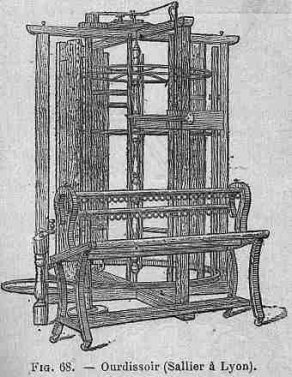
RAISING THE WARP
Once warped and before the beaming (wrapping on the back beam of the loom), the warp is "raised", ie wound on a horizontal drum.
It is with this drum that the warp will be wrapped on the warp beam of the loom with the use of a new tool, the raddle (or dividing comb) ...
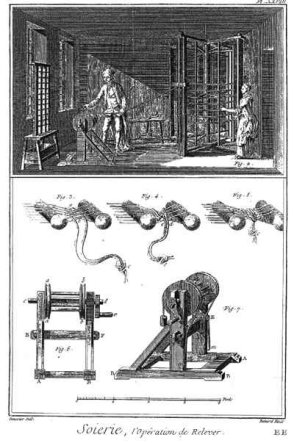
THE MOBILE HECK BOX
This picture details the heck box of the warping machine. The two recesses can be seen in the height of the heck box. Indeed, the vertical upright of the drum frame on which the heck box slides is in fact double. This allows a much better sliding than would be possible with a single post and a single recess on the heck box. The two small sleeves fixed to the heck box, as well as the three rods allow to regulate the threads and to apply to them an equal tension.
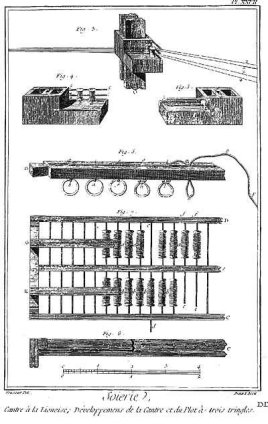
UPRIGHT CREEL AND BENCH
The warping machine is accompanied by a bench with a crank and a belt wheel connecting the lower wheel of the warping drum, drawing an eight. The warper sitting on this bench maneuvers the crank to turn the warper.
The warping machine is also accompanied by a creel that receives the unwound thread spools which will make it possible to form the warp on the warping machine.
On this engraving we see a warping machine sitting on its bench and maneuvering the warping machine, and we distinguish the threads coming from the creel joining on the heck box of the warping machine before winding on the drum of it .
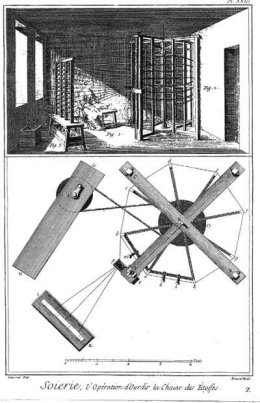
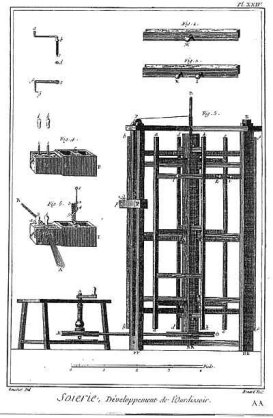
The Lyonnais warping machine is quite a luxurious manufacture in the choice of the woods used and the more or less complex shape of the pieces that compose it.
It is composed of a drum one meter in diameter with 8 vertical uprights arranged around a central axis flanked at each end of a metal rod, the top of which is clearly longer than the bottom.
This movable drum is fixed on a frame formed of 4 vertical uprights of approximately 2 meters in height and two crossbars up and two crossbars down in the shape of a cross whose center is pierced by a hole receiving the metal rods of the shaft of the drum. A wheel attached to the bottom of the drum, on its central axis, causes it to rotate.
One of the 4 uprights of the frame passes through the heck box which slides vertically on it. The heck box slides on this upright in an upward or downward movement according to the direction of rotation of the drum. Indeed, a cord connects the heck box to the drum via a pulley and winds (or unwinds) around the upper metal rod of the drum axis, thus forcing the heck box to be mounted or lowered on the drum upright of the frame.
Lyon warping machine
